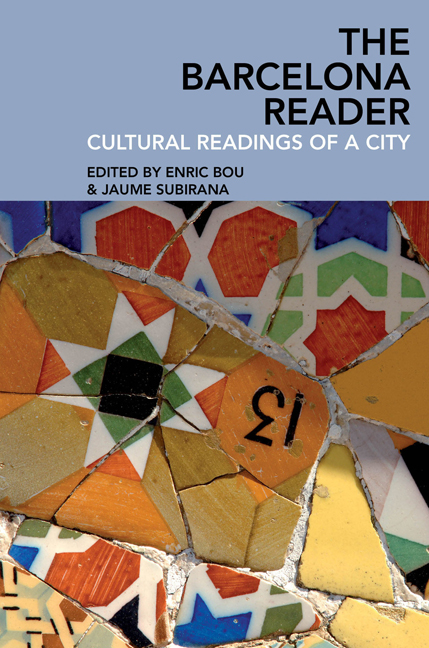Book contents
- Frontmatter
- Contents
- List of illustrations
- Notes on contributors
- Introduction: Barcelona: Cultural readings of a city
- I City, history, and territory
- II City and society
- III Art, architecture, and the city
- 10 Picasso among his fellows at 4 Gats: Beyond Modernisme?
- 11 Gaudí: Poet of stone, artistic hedgehog
- 12 El Poble Espanyol / El Pueblo Español (1929)
- IV The Olympics and the city
- V Literature, cinema, and the city
10 - Picasso among his fellows at 4 Gats: Beyond Modernisme?
from III - Art, architecture, and the city
- Frontmatter
- Contents
- List of illustrations
- Notes on contributors
- Introduction: Barcelona: Cultural readings of a city
- I City, history, and territory
- II City and society
- III Art, architecture, and the city
- 10 Picasso among his fellows at 4 Gats: Beyond Modernisme?
- 11 Gaudí: Poet of stone, artistic hedgehog
- 12 El Poble Espanyol / El Pueblo Español (1929)
- IV The Olympics and the city
- V Literature, cinema, and the city
Summary
The international renown of the tavern called 4 Gats (4 Cats) on Carrer Montsió in Barcelona is due mostly to the fact that Pablo Picasso had his first solo show there, in February of 1900. Biographers and scholars have stressed the importance of this show because it was then that the young painter's work left behind the academicism of his formative years and began to show remarkable maturity and individuality. The fact that Picasso burst upon the scene in a tavern, in this tavern, is worth noting, because 4 Gats became the place where three things came into contact or, perhaps, rubbed against one another, and served to catapult Picasso to fame. First of all, as we will see, 4 Gats was intergenerational, in the sense that two generations of artists met there. 4 Gats was also an interdisciplinary space, where painters interacted with sculptors, illustrators, architects, musicians, and, especially, writers of various genres. And, finally, 4 Gats was the place where travellers met on their way to and from Paris, then the capital of Western culture. Pere Romeu's bar was a failure as a business, but for a few years, from its opening in June of 1897 until it closed in July of 1903, 4 Gats actually managed to emulate the mythical cafes of Montmartre that were its inspiration. For Picasso, as Eduard Vallès has written, ‘it was a place for meeting the intelligentsia of the time […] and it foreshadowed, on a small scale, the modernity that he would later encounter in the French capital’ (2015a: 78; my translation).
The Catalans who knew first-hand the milieu of the Parisian cabarets patronized by important Impressionist and Post-Impressionist painters such as Manet, Degas, Renoir and Toulouse-Lautrec were the artists Ramon Casas, Santiago Rusiñol and Enric Clarasó, and the critic Miquel Utrillo. Together and separately, they had spent time in Montmartre, and with their exhibitions and activities in Barcelona during the nineties, they became ambassadors of the latest trends in art and magnets for the young artists of Barcelona. Just like their French predecessors, the Catalans became firm proponents of plein air painting and rejected altogether religious, historic and other subject matters favoured by the Academy. From Paris they brought along the myth of bohemian life, together with a predilection for urban topics that portrayed the new scenarios of the urban middle class.
- Type
- Chapter
- Information
- The Barcelona ReaderCultural Readings of a City, pp. 243 - 264Publisher: Liverpool University PressPrint publication year: 2017

